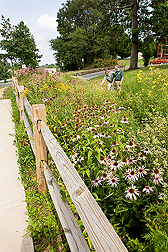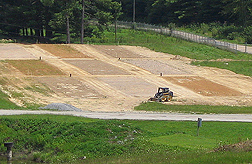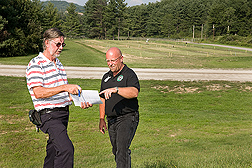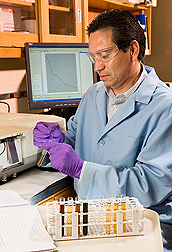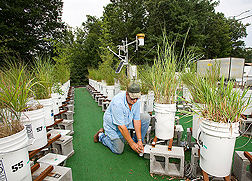Better Ballfields and Rain Gardens Start Below the Surface
The townspeople of Beaver and Beckley, West Virginia, soon may not have to look any farther than their neighborhood ballfield or rain garden to see the benefits of Agricultural Research Service (ARS) research.
The Appalachian Farming Systems Research Center (AFSRC) at Beaver, West Virginia, is the only ARS lab working on constructed or replacement subsoils and topsoils for growing better turfgrass on ballfields, for growing rain gardens that not only reduce rain runoff but also clean pollutants from rainwater, and for growing vegetation on former mineland.
National Turfgrass Research Initiative Works With ARS
The constructed-soil initiative is in its fourth year. ARS is doing the research in cooperation with the National Turfgrass Research Initiative, Inc., a joint turfgrass industry/ARS program created in 2007. The initiative partners the expertise of ARS and universities. The turfgrass industry has set a high priority on improving degraded soils by constructing soils that include readily available rural, urban, and industrial byproducts that can be mixed with local soils.
Working With Everybody
ARS lead scientist Rich Zobel and the soil resource management team at AFSRC work with USDA’s Natural Resources Conservation Service (NRCS); the city of Beckley, West Virginia; the Raleigh County Solid Waste Authority; West Virginia State University at Institute; West Virginia University at Morgantown; Virginia Tech at Blacksburg; the University of Ohio at Akron; and various ARS labs, including two regional research centers. Two local groups interested in water resource management and the U.S. National Park Service are also doing rain garden projects.
Zobel says these collaborations “add expertise in civil engineering, economics, landscape design, and environmental regulation.”
Zobel and research associate Amir Hass, who is with West Virginia State University and stationed at Beaver, work with Doug Boyer, a hydrologist, Charlie Feldhake, a soil scientist, and Javier Gonzalez, a soil chemist, all at AFSRC.
Constructed soil is a much more sophisticated version of the home gardener’s method of improving the soil by blending in sand, topsoil, and organic amendments such as humus, composted manure, sewage sludge, or yard and garden clippings.
A good constructed soil goes way beyond these conventional recipes. Research and chemical analyses are used to determine what is needed to ensure that soil does not become compacted and has excellent drainage, water-holding capacity, and aeration properties, plus essential nutrients for robust plant growth.
Finding the Best Soil Recipes
Zobel and colleagues are formulating recipes for constructing “designer soils” from various source materials in Ohio, Kentucky, Tennessee, West Virginia, Virginia, and southern Pennsylvania and using materials such as mine spoils, coal-combustion byproducts, poultry litter, and biochar as amendments.
So far, the most promising mixture contains quarry byproducts and composted chicken litter. It has met predetermined requirements such as the ability to transmit stormwater and sustain turfgrass or other vegetation. Chicken litter is the best organic component found so far. Chicken litter is a mixture of droppings and bedding materials—usually sawdust and wood shavings. The litter is composted in a “digester,” designed by West Virginia State University, to stabilize the mixture and remove odors and harmful microbes. Three years of testing have shown the composted poultry litter works as well as commercial fertilizer in establishing vegetation on the mined soils.
|
|
Zobel is initially focusing on compacted soils. He says, “Soil compaction is the first cause of problems in growing good, robust grass on ballfields and other sites. Compacted subsoil causes the grass roots to stop short, restricting the amount of soil water available. These grasses grow weakly and are easily killed by heavy use of the site.”
The scientists established experiments at the Raleigh County landfill site. They have several students from Virginia Tech working on various projects to design the specifications for bringing former landfills back into use as ballfields or residential or commercial sites.
At the landfill site, they are testing subsoils with varying levels of compaction overlain with three depths of topsoil. They will plant turfgrass and determine which combinations provide the most suitable turf. From this will emerge the best management practices for building subsoil and topsoil for playing fields. As part of the project, Virginia Tech researchers are also testing nearby football and soccer fields for compaction and nutrient content to determine recommendations for field renovation specifications.
Rain Gardens Sprouting Up Everywhere
Rain gardens are increasingly popular with homeowners and municipalities and are mandatory for many communities nationally. They are plantings in manmade depressions that catch stormwater runoff from sidewalks, parking lots, roads, and roofs. Rain gardens are constructed in various shapes and sizes, from large basins carved by front-end loaders to small streambed-like formations complete with pebbles. Not only do rain gardens slow water down to give it time to soak into the ground and be used by plants, but they also filter out sediment and chemical pollutants.
|
|
Many gardens use mainly native flowers with some grasses, but the “constructed swale” type of rain garden uses turfgrass. The only water the plants receive is the runoff from rain. Homeowners usually direct the runoff from their rain gutter downspouts with lengths of plastic corrugated drainage pipe.
“Some rain gardens, as well as ballfields, have had to be torn out and rebuilt because they weren’t built right,” says Kevin Morris, executive director of the National Turfgrass Evaluation Program. “You have to draw on scientific research to get fields and rain gardens right the first time.”
Biochar To Clean Rain Garden Water
Hass, Gonzalez, and Zobel want to take that several steps further. They are working with the ARS Southern Regional Research Center (SRRC) in New Orleans, Louisiana, and the ARS Eastern Regional Research Center in Wyndmoor, Pennsylvania, to use biochar in rain garden soils to neutralize fertilizers, pesticides, and chemicals leaked by cars. The most familiar example of biochar is the activated charcoal used in aquarium filters. Biochar is produced by subjecting materials such as coal to either gasification or pyrolysis. These are both extremely high-temperature processes that take place in the absence of oxygen.
SRRC chemists Isabel Lima and Wayne Marshall (now retired) developed an ARS-patented method for turning agricultural biowaste into material similar to activated charcoal. But their materials are superior to activated charcoals.
Hass, Gonzalez, and Zobel are cooperating with colleagues at the regional research centers who are interested in biochar made from a mixture of poultry litter and peanut shells. They found that poultry litter biochar is a powerful pollutant magnet. It can attract heavy metals such as copper, cadmium, and zinc, which are ordinarily tough to snag, from wastewater.
Zobel is experimenting at two demonstration rain gardens in the Beaver area, as well as at plots at a county landfill and a mineland reclamation site.
Money for Sporty Topsoil
Morris says, “There is money for constructed-soil research for golf courses and college and professional-level playing fields, but not for sports fields at the high school, elementary school, or park levels—until now. The costs are lowered by using inexpensive byproducts available locally.”
From their past research, ARS scientists know that certain soils are unusable for ballparks and rain gardens because they tie up phosphorus, making it unavailable to plants. Therefore, ARS is working with the West Virginia Natural Resources Council and NRCS to develop a computer model that will help users choose which local soils are best for ballparks, soccer fields, rain gardens, and other uses. It will use the NRCS soil survey data, the first such use of this data.
Natural Turf vs. Artificial Turf
“Natural turf can get a bad name from overuse of poorly constructed fields,” Morris says, “but it is an inexpensive alternative to artificial turf. It can compete well when everything works. Natural turf has all the resiliency of artificial turf.”
Over the long term, Zobel envisions new turfgrass varieties, possibly perennial ryegrass and tall fescue, that will penetrate compacted soil and renovate fields without the need to till the compacted soil. “We have a lot of information from previous research on roots, soils, and microbes that we can draw on for the constructed-soil project,” Zobel says. He sees an eventual extension of the constructed-soils research and demonstration projects to homeowners and homebuilders for improving their lawns and rain gardens.
This research should one day help provide specifications for improved turfgrass fields that even the smallest of parks and schools can afford.—By Don Comis, Agricultural Research Service Information Staff.
This research is part of Soil Resource Management (#202), an ARS national program described at www.nps.ars.usda.gov.
To reach scientists mentioned in this article, contact Don Comis, USDA-ARS Information Staff, 5601 Sunnyside Ave., Beltsville, MD 20705-5129; (301) 504-1625.
"Better Ballfields and Rain Gardens Start Below the Surface" was published in the November/December 2010 issue of Agricultural Research magazine.







